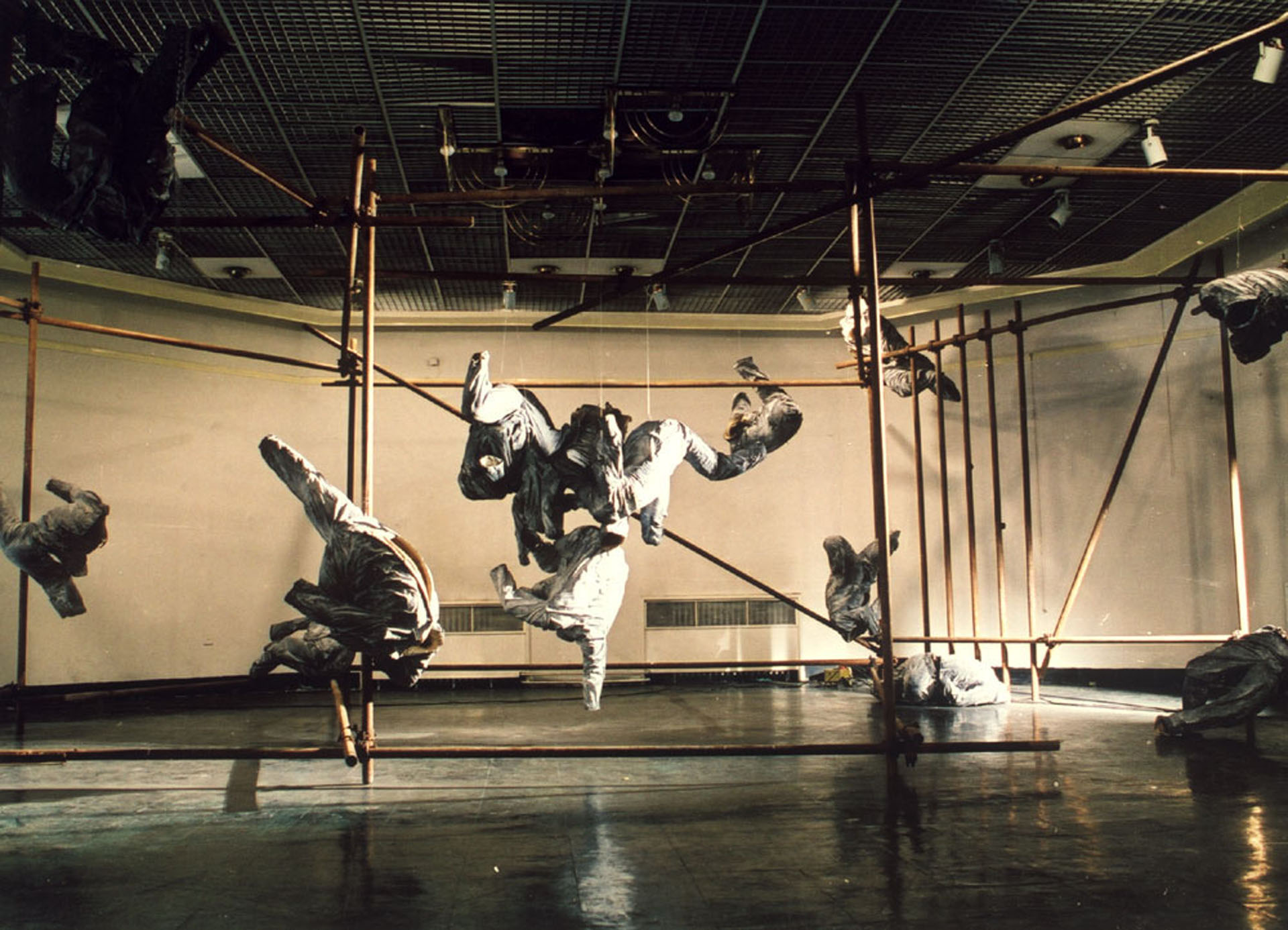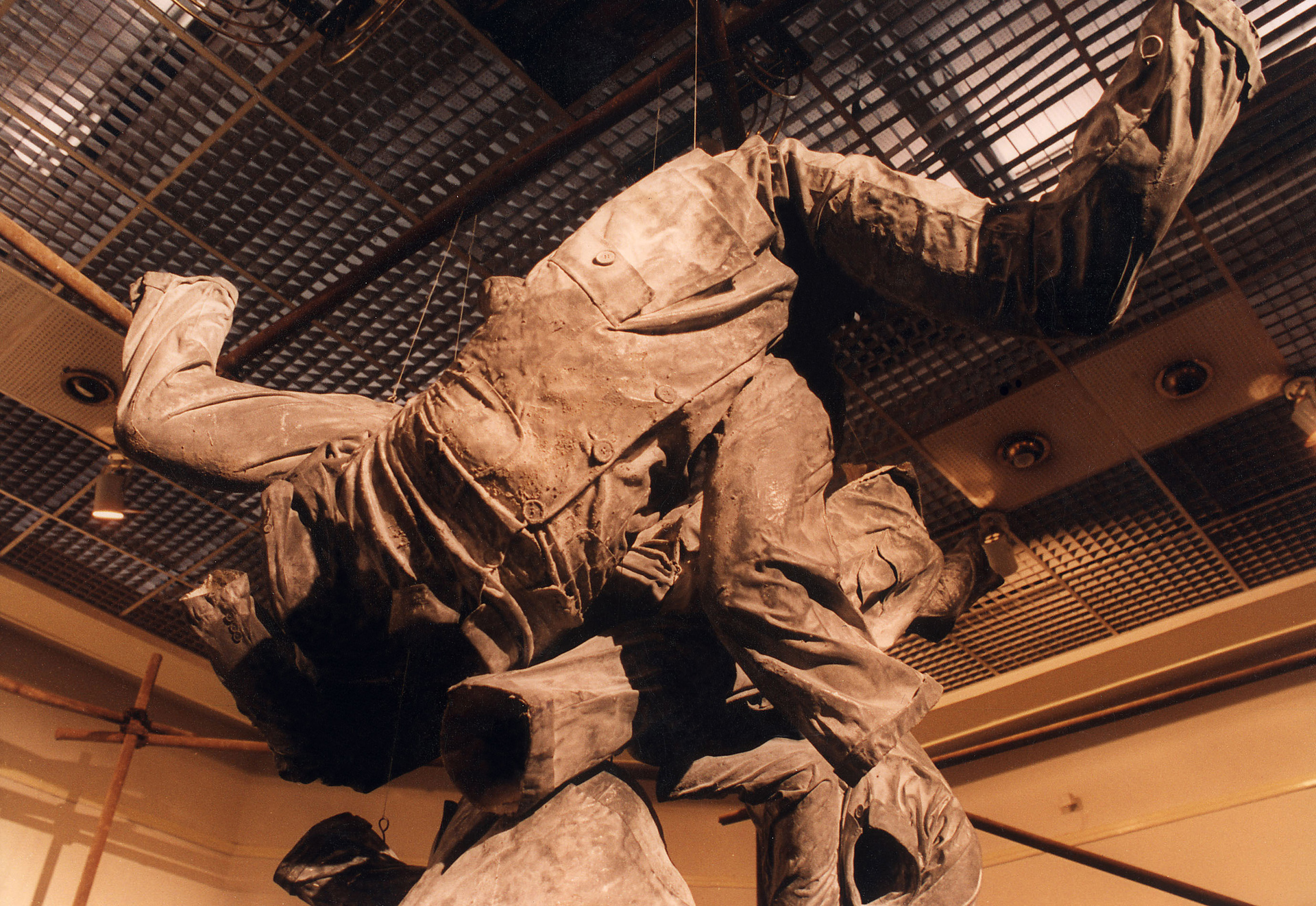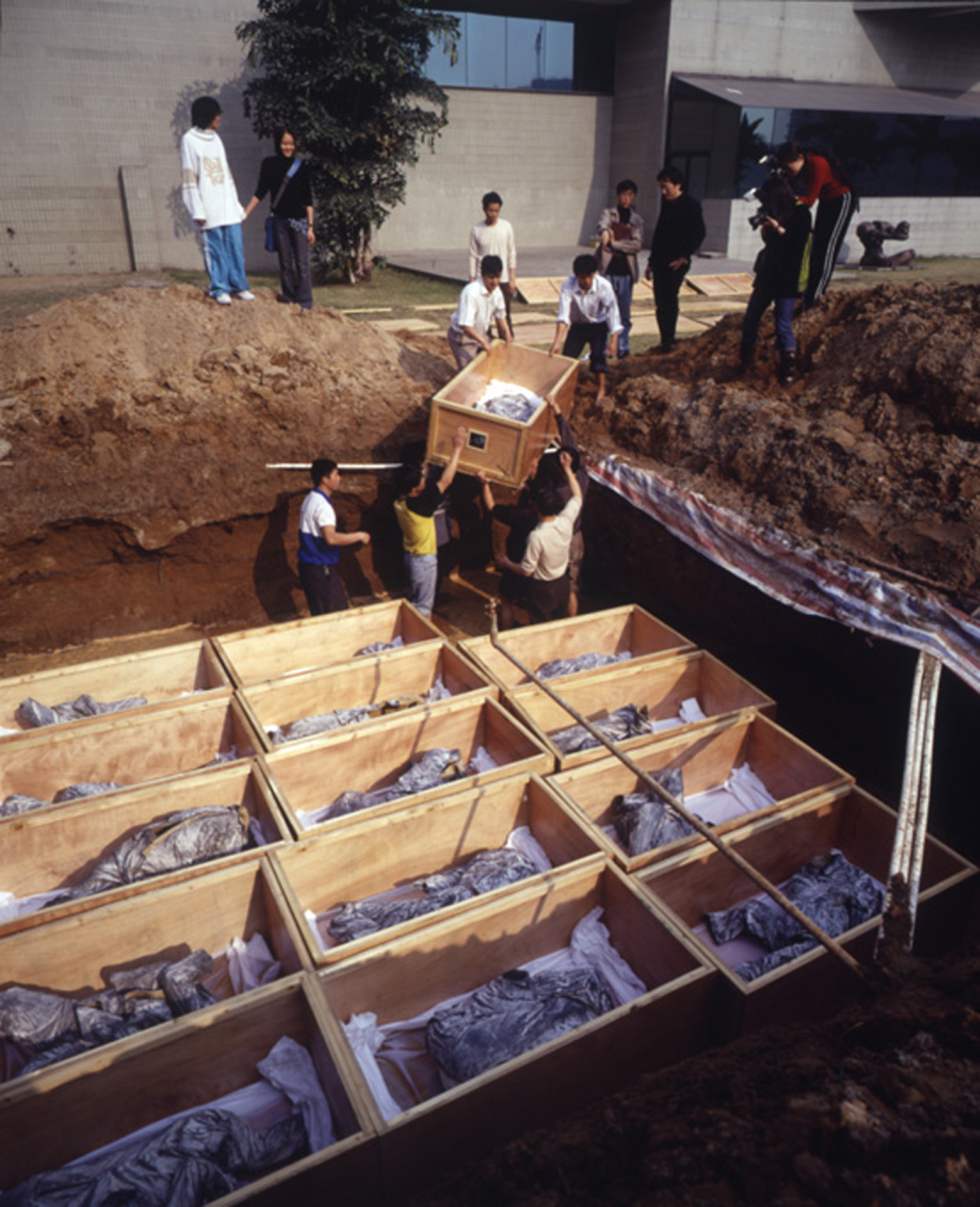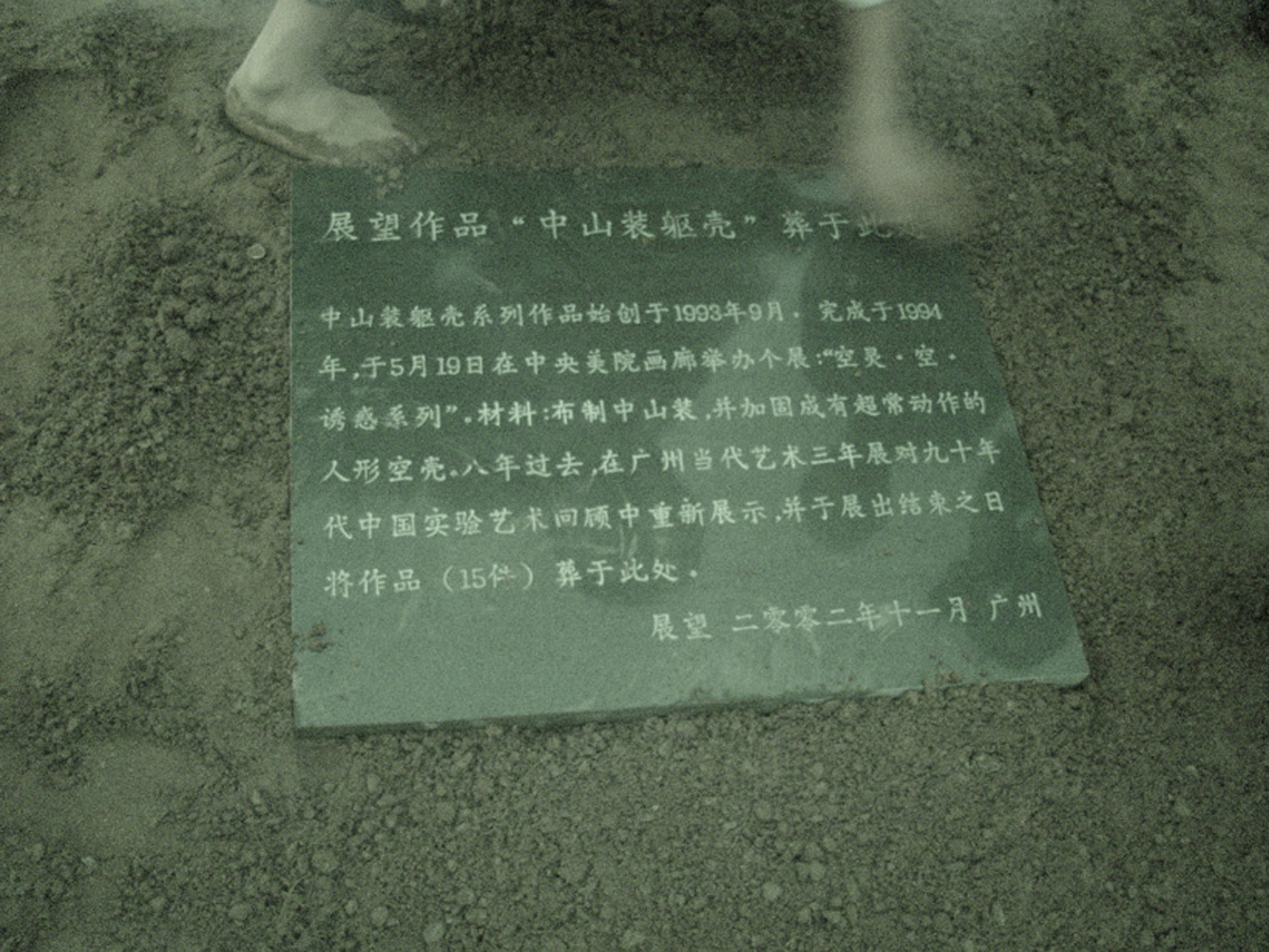Mao Suit
The Mao suit 1994-2002
“Empty Soul Empty---Temptation series”------ A brief explanation of the Mao suit series:
This series of sculptures was started during the second half of 1993, and was first exhibited in the month of April in 1994. When the 18 sculptures of the series were exhibited they were suspended in their fall from scaffolding or rested writhing on a mound of dirt. This series of works was named ““Empty Soul Empty---Temptation series.” The movements portrayed in these sculptures are all different, but at the same time they are all characterized by being unusual movements. The final result of the artist’s experimentation is a series of empty shells representing the Mao suit whose unusual contortions look both appropriate and in conflict with the seriousness and gravity the Mao suit has conveyed for a century. Apparently this was just a game carried out by the artist, but what lies under the façade of this game does really represent the artist’s thought about desires and his attention and perception towards people’s psychological twists and turns. It is like when we see a cicada abandoning its cast: even if it seems a real struggle, it is just the process of abandoning the cast and of emptying the cicada has to go through. This work brings together the conflicting notions of braveness and nihility, and is aimed at reflecting on the interaction between the sense of gravity and of lightness residing in people’s hearts. “Because of the specific artistic language of Zhan Wang, even if the Mao suits, their contortions and their way of being displayed all carry a clear link with society, the extraordinary aspect of this work lies in the relationship it creates between real and surreal. This is also due to the material feeling realistically conveyed through the texture of the cloths combined with a feeling of emptiness. (Quote from Li Xianting in Beijing Youth Daily, 1994, 6-14)
Chinese Contemporary art – sculpture section (edited version)
“Burial-The Mao suit series” Fifteen shells of Mao suits are buried under the Guangdong Art Museum, Guangdong, China
Material: Mao suits and mixed media
Shells’ size: Life like size
Size of the wooden crates: 160X90X60cm
Size of the pit: 5X5X1.5m
On the last day of the exhibition, the works were buried under the Guangdong Art Museum.
Year: The work was created in 1993-1994, and buried in November, 2002.
Remarks: The presence of a tablet inscription on the spot
Front inscription:
Zhan Wang’s work “Mao suit shells” is buried here.
Back inscription:
The series of works “Mao suit shells” was started in September 1993 and was completed at the beginning of 1994. On May 19 of the same year, the solo exhibition of Zhan Wang “Empty Soul Empty--- Temptation series” was organized at the Central Academy of Fine Arts in Beijing. The works exhibited included the Mao suits, as well as life like size empty shells portrayed making unusual movements and contortions which were set on a mound of dirt or suspended in their fall from scaffolding. Eight years after, on the occasion of the Guangzhou Triennial whose topic is reinterpreting Chinese contemporary art 15 shells are buried here.
The Guangzhou Triennial closed its doors on January, 19 and on the same day of the closing ceremony at two p.m. Zhan Wang completed his plan of burying the Mao suits. The process was as it follows:
Zhan Wang
November, 2002 Guangzhou
Some explanations of the Mao suit series:
The issues concerning the aesthetical function of artworks should be left to be discussed to our successors. Once the artistic issues disclosed by a certain epoch vanish then successors will just inherit the artworks’ formal beauty. But real artworks right during the epoch they are created are extremely helpful to solve the inner anxieties of the people of that peculiar period of time.
These shells can be situated between the human and the animal realm, since they are moving towards two different trajectories: the personal one and the societal one. (Referring to the notion of temptation)
The contortions of these shells are highly abnormal, even if the cloths they wear are extremely normal. The Mao suit has a symbolic meaning, since it has been a symbol for Chinese politics and culture for a century. The education Chinese people were given has forced all of us to wear an invisible Mao suit.
I decided to use the Mao suit because it is the object I remember the most and most clearly. I think that it can exactly represent a century, being the trace of a period rooted in our innermost feelings. Even if the aim of cloths is to conceal and protect the body, clothes are also the mirrors of the grade of civilization of a certain epoch. Once I put the Mao suit on these abnormally long bodies it is as if I make the inner and spiritual feelings of a person become a visible shell.
The sense of gravity, seriousness and sense of inflexibility conveyed by the Mao suit combined with its abnormal contortions and with elongated bodies are two extremes which carry within them a sense of drama and conflict. In this state of painful despair I found out the beauty of art, I changed this notion, started to appreciate it and then finally praise it.
Empty Soul Empty---A talk about the creation of the “Temptation series”
During the last years I have committed myself to making sculptures with plaster; it seems very hard for me to abandon this rather primitive and traditional language of expression. This is because I think that when I use a soft material like plaster to shape the different parts of a person’s body, I feel overwhelmed with joy. Even from the very first steps of the preparation of the small sketches, a sculpture can be observed from different angles, and this stimulated me so much that I gradually took the distances from the real world in order to flee into a world made of illusions and fantasies.
I regard the human body as a sort of living organism endowed with social attributes. For me it is characterized by primordial animal instincts and desires while at the same time being controlled by rationality. The arms and the torso [in these artworks]change their positions in tandem with my feelings and mood, then the more the body does unusual movements the happier I am also because I have the feeling of being able to reinvent myself. Every time I move a part of the body in a bold and drastic way to assume an improbable position, I feel very relieved. My usual thoughts make me more and more grieved, till the point of feeling desperate. But when I mould figures, this kind of positive feeling conveyed by the act of shaping figures let me feel completely void. I usually experiment and explore new possible movements, I go on experimenting till when I reach the point that movements don’t have a meaning anymore, to the point that even the body doesn’t exist anymore. Perhaps this can reflect the fact that in the end what really matters and is pursued is a state of happiness brought about by a feeling of illusion.
Then these hollow shells are combined with ready made objects present in nature, at this point I am able to develop and combine together the personal, societal and natural elements in my work.
Actually, the work “Empty Soul Empty--- Temptation series” is just a fragment of what I want to express in more general terms.
Natural Temptation “Clear sky art” 1994
[My aim is]To get rid of the body by keeping only its outer shell that is constituted by the clothes. Request: To maintain the life like results of the movements of the body, the shape of the body and the folds of the clothes.
This was my very first idea when in 1994 I started to work on the piece “Temptation.”
The starting point of this work was a rather absurd idea, but even if I tried to follow a more rational path to create my piece, I found myself entangled with the absurd dimension. Later on I transformed many assumptions into real possibilities.
The shells had to preserve the real aspect they had before I started to work on them and change them. The spiritual transformation they went through was similar to that of a cicada: the moment just before the transformation of a cicada occurs the cicada has already reached the highest grade of suffering and of convulsion. This specific detail provided me with the inspiration to portray human figures while making unusual contortions. The crux of the point was in the fact that this work used the combined notions of void and lightness to express the state of mind mentioned above. The Mao suit is a cultural metaphor responding to a specific meaning, and it is because I noticed this aspect that I employed it as a medium in my sculptural works in a highly overt way.
When a certain living organism cannot follow its own natural course of development because it is influenced by outer forces that make it develop in an unnatural way, then its form often appears to be distorted.
Because of the outer pressures, life’s real needs cannot do but retreat, responding to what is labeled as the rule of “the survival of the fittest.”
Once people’s thought and actions have become abnormal, people turn submissive, utilitarian, and even kitsch. But what we mean by the notion of “person” still remains; therefore the notion of “person” in itself has not become abnormal. Genuine knowledge always presents itself as intuitive knowledge; but the so called “rules of survival” always menace people who constantly fight painfully against the contrasting feelings of pressure and relief. The combination of primeval desires with the control exerted by education has given birth to the sad and moving song of the evolution of human civilization.
Desires have brought catastrophes and pain to humanity, but desires have also been able to encourage humanity go on living with a positive attitude right because life should go on and develop.
These shells are the secretions of my art and life; actually they have already turned into natural elements. A direct cause of this is that I have always been trying to get rid of human traces even in those artworks of mine filled with charm.
The direct understanding of many issues will cause our mind to feel suspended, pervaded by a feeling of fakeness, instability and at the same time joy. The relationship among art, life and politics has obliged us to find a new way to go on living, but this illusory way of living is a great temptation for those who have been trying over the years to free the spirit.
Zhan Wang
Beijing, Sanlitun Chaoyang District
September 11, 1994















